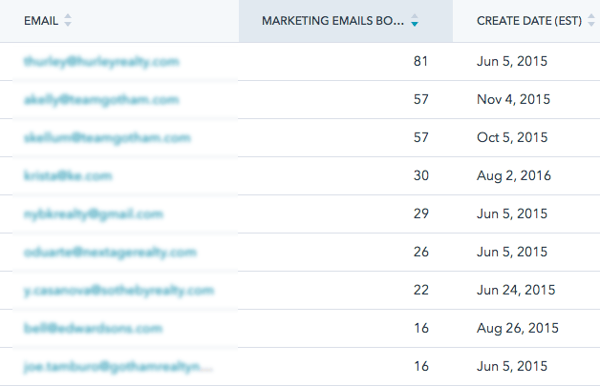You've decided that it's time to clean up your HubSpot contacts database. There are some people who consistently bounce, there are some old (and questionably obtained) contacts and there are those who you just know are in there twice because they've moved companies at some point in the last few years. Tackling your contacts list in an actionable way can be tricky, especially if you have a LOT of contacts, so here's a starting point for your reference.
Invalid Contacts
Some contacts are not real. They're gibberish entered because someone didn't want to share their actual contact data with you. Sometimes people get really creative:

But most people are lazier than that and go for the default asdfs approach:

A few searches for contacts like this can scrub your list of invalid contacts that you really don't need to be hanging on to.
Bounced Emails
There is a difference between hard bounces which are completely rejected by the server because they don't exist (like those guys 👆) and soft bounces which might be a server rejection because the mailbox is full, the server couldn't connect or the email you're sending is too large and gets rejected.
You can have a contact who has bounced emails but is still an active client that is receiving other communications from you, so don't go deleting all your marketing email bounces right away. Take a look at their creation date and date of last activity to gauge who is stale and bouncing and who is just bouncing. Unless they have 81 bounces, then you can remove them immediately 😱.

Email Lists
Some contacts end up in marketing CRM limbo, receiving too many of your marketing emails or none of your marketing emails. Double check some of your most common lists against each other and make sure that people are getting enrolled as you would expect them to. Reviewing your lists will also alert you as to which contact properties are important for list generation and can help to identify gaps in your data collection and contact management process.
Date of Last Activity
HubSpot tracks all kinds of things and knows when you've been reading your emails or visiting the site. If the last date of activity is years ago, you've got a good candidate for removal. For this you'll want to be conscious of your sales cycle and use it as your guide for 'how old is too old' and to assess whether you'd expect someone who has fall out of the funnel to pop back in.
First Name/Last Name Unknown
Like an international Man of Mystery slipping into your CRM in disguise, these contacts often go unnoticed. They're the ones that receive the default personalization token ("Hi There,") because their information is unknown. This happens if you don't require people to put their names in for a form submission of if you're importing a list with shoddy data. Generally, if you have an email list but no name you need to stop and ask yourself how that contact got there so that you can clean up your data collection process.
Key Performance Indicators
If you’re using HubSpot as it’s meant to be, you’re likely capturing some key performance indicators in their contact record. Things like being a member of a certain mailing list, their lifecycle stage, lead status or negative lead scores can give you an idea of who is valuable and who is not doing much of anything. Filter your list to exclude people who you know hit your main KPIs, then take a look at who is left. Some of these contacts will be great candidates for removal.
The more contacts you have on your list, the harder it's going to be to narrow these down. This is also true if you have a long sales cycle, deal with multiple contacts at the same company and if you have loads of forms gathering information for a wide variety of means. In these cases, you'll want to take a step back and look at the entire data collection process to assess what you're collecting this information for and why. Doing a full process audit can help you make sure you're collecting valuable contacts to help you meet your business goals and not just inflating your contacts list with asdf@asdf.com.








